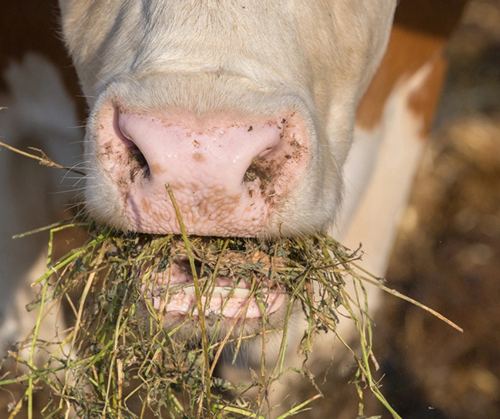Nutrition Reminder: Annual Pre-Calving and Lambing

This winter has presented many challenges, and the unpredictable weather makes planning diets and feed for livestock more difficult. Nutrition in the lead up to, and post, calving and lambing will directly impact youngstock survival, performance and fertility within your herd and flock. Therefore, this is your reminder, that if you haven’t already devised your livestock feeding regime ahead of this critical time – to act now.
Forage Analysis
The best place to start is to complete forage analysis, to determine the quality of your silage and/or hay on-farm. By performing this analysis, you can possibly avoid unnecessary over supplementation of concentrates, and ensure you aren't compromising animal performance by assuming the forage quality is higher than it actually is.
Forage that is available on-farm will generally be your most plentiful and cheapest feed source throughout the winter. Knowing what you are working with can allow you to make business decisions in advance of any issues arising. In addition, on mixed farms, forage analysis can also be useful in allocating which forage is best to be feed to particular groups and types of stock to best benefit livestock performance and reduce feed costs.
Through the backend of 2024, we've seen huge variations in forage analysis results from our laboratory, which highlights why it's so important to test its feed value. This low-cost investment in your livestock’s nutrition, should always be one of your first steps to ensuring your herd and flocks performance pre and post calving and lambing. If you are still to complete forage analysis this year, speak to your local consultant or feed representative about getting samples to the laboratory as soon as possible.
Formulating a Ration
When you have forage analysis results, you can greatly improve the accuracy of a ration prepared for either cattle or sheep. The most important factor in completing a ration is to optimise home-grown forages and cereals that you already have on-farm. You can then identify whether additional feeds need to be included to make a good balance for the stock.
To formulate a ration the key pieces of information you will need is:
- Weight of cows/ewes (physically weigh them, or use cull weights for a sensible estimate – there can be a wide variation within each farm).
- Stage of pregnancy - is weight gain/loss/maintenance required? Avoid trying to loose/gain dramatic amounts of weight or condition closer to calving/lambing.
- Forage analysis.
- What feeds are available – homegrown forage, cereals, current concentrate feeds in stock or feeds available to you. Feed labels are a great source of information.
Once you have this information to hand or if you have any concerns regarding your current ration, sit down with your local consultant, nutritionist or feed adviser to discuss. This will also help to plan feed stocks throughout the remainder of the winter or to lock contracts with feed companies.
It should be noted that this should be done as soon as possible to allow some time to make tweaks to their nutritional intakes before stock reach the critical and demanding last four-six weeks of pregnancy.
Metabolic Profile Tests
Metabolic profiling involves blood testing a number of cows or ewes (usually between 6-20), that are representative of the herd or flock, within three to four weeks pre-calving/lambing. The results will let you know whether livestock are receiving the correct balance of protein and energy within their diet, along with an adequate mineral supply. The results can be very useful to allow you to get ahead of the game in knowing how the breeding females are coping coming into the time where the demand on them is at its highest; from calving/lambing, preparing enough colostrum, ensuring a plentiful milk supply, through to recovering quick enough to get back in-calf/in-lamb for the following season. This is ever more important moving forward within beef suckler herds, with updated eligibility of calves claimed under the Scottish Suckler Beef Support Scheme (SSBSS), as calves will only be eligible for payment if their dam’s calving interval is 410 days or less.
Consult with your vet to organise metabolic blood testing to get the timing right - testing too early means the stock aren’t under enough pressure to detect potential issues, testing too late doesn’t leave you enough time to make tweaks and changes before the calves/lambs are born.
Remember the Lads
Finally, don’t forget about your bulls and rams. Ensuring that they receive the correct nutrition throughout the winter will improve their health and fertility in the coming breeding season – ensuring that they are ready for action when you need them!
Five Top Tips
- Perform forage analysis and study the results.
- Weigh and condition score cows/ewes now! Allow time to adjust their nutrition gradually before the final stages of pregnancy, if required.
- Formulate rations with your adviser and update as season moves on/changes occur.
- Carry out metabolic blood profiling on cows/ewes in the final three to four weeks of pregnancy.
- Download the FAS Companion app to your mobile phone, to access the forage and feed budget tool.
Useful Resources
Samantha Stewart, Consultant, Samantha.Stewart@sac.co.uk

Unearthed is the exclusive SAC Consulting members' monthly newsletter. Unearthed offers insights and tips from our experts on what we think is in store for farming and crofting in the coming months in order to protect and enhance your business.
Posted by Unearthed News on 20/01/2025
